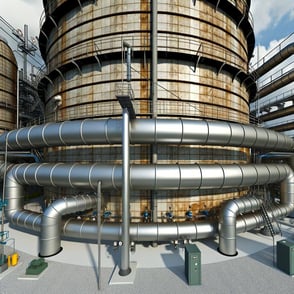Hydrogen Energy Storage
Hydrogen storage is vital for energy, transport, and industry, using methods like compressed gas, liquid hydrogen, and chemical storage to safely store hydrogen efficiently.
What is Hydrogen Energy Storage?
Hydrogen storage is a crucial aspect of the hydrogen economy, involving the containment of hydrogen for various applications, including energy storage, transportation, and industrial processes. As a clean and versatile energy carrier, hydrogen can play a significant role in reducing carbon emissions and enhancing energy security. Efficient storage methods are essential to harness the full potential of hydrogen as a renewable energy source.
How Hydrogen Storage Works
Hydrogen storage involves various methods to store hydrogen in a safe, efficient, and practical manner. The primary methods include compressed hydrogen gas, liquid hydrogen, and chemical hydrogen storage. Each method has its advantages, challenges, and specific applications.
Compressed hydrogen gas storage involves storing hydrogen in high-pressure tanks. This method is widely used due to its simplicity and relatively low cost. Hydrogen gas is compressed to pressures typically ranging from 350 to 700 bar (5,000 to 10,000 psi) and stored in cylinders made of materials like carbon fiber composites or metal alloys. This process of compressing and storing hydrogen gas is straightforward and well-understood, and existing infrastructure for compressed gas storage can be adapted for hydrogen. However, compressed hydrogen has a lower energy density compared to liquid hydrogen and chemical storage and high-pressure storage poses risks of leaks and explosions if not managed properly.
Liquid hydrogen storage involves cooling hydrogen to cryogenic temperatures (below -253°C or -423°F) to convert it into a liquid state. This method allows for higher energy density storage compared to compressed gas and is used in applications where volume efficiency is critical, such as space exploration. This for of storage is easier to transport in bulk compared to compressed gas, and has a higher energy density than compressed hydrogen gas, allowing for more compact storage. The challenges lie in the fact that maintaining extremely low temperatures requires sophisticated and expensive insulation and cooling systems, and that hydrogen is lost due to evaporation, especially during long-term storage.
Chemical hydrogen storage involves storing hydrogen in chemical compounds, such as metal hydrides, ammonia, and liquid organic hydrogen carriers (LOHCs). These materials can release hydrogen through chemical reactions when needed. Chemical storage methods often offer safer alternatives by storing hydrogen in non-volatile compounds, and are suitable for long-term storage without significant losses. Extracting hydrogen from chemical compounds can be complex though, and may require additional energy.
Green hydrogen, produced using renewable energy sources, plays a crucial role in sustainable energy systems. In these systems, renewable energy sources provide electricity to the URFC (Unitized Regenerative Fuel Cell) or electrolyzer, which splits water (H₂O) into hydrogen (H₂) and oxygen (O₂). The produced hydrogen gas is then compressed and stored in a high-pressure hydrogen gas storage tank, ensuring efficient storage until needed. When energy is required, the stored hydrogen is fed into a fuel cell, which converts hydrogen and oxygen from the air into electricity, with water as the only by-product.

The Impact of Hydrogen Storage on the Energy Sector
Hydrogen storage has a profound impact on the energy sector by enabling the use of hydrogen as a versatile and clean energy carrier. Efficient hydrogen storage solutions are essential for integrating hydrogen into various applications, from renewable energy storage to fuel cell vehicles and industrial processes.
Hydrogen storage plays a critical role in integrating renewable energy sources like wind and solar power into the grid. Excess renewable energy can be used to produce hydrogen through electrolysis, which can then be stored and converted back into electricity or used in other applications when needed. This capability helps balance supply and demand, enhancing grid stability and reliability.
Hydrogen storage use is becoming increasingly widespread in transportation through fuel cell vehicles (FCVs). FCVs use hydrogen stored on-board to generate electricity through fuel cells, providing a clean and efficient alternative to traditional internal combustion engines.
The storage of hydrogen also supports various industrial applications, including ammonia production, metal refining, and chemical manufacturing. Efficient storage methods enable the use of hydrogen as a feedstock and energy source in industries seeking to reduce their carbon footprint and transition to more sustainable practices.
By enabling large-scale and long-duration energy storage, hydrogen storage enhances energy security. Stored hydrogen can be used during periods of high energy demand or supply disruptions, providing a reliable backup energy source. This capability is particularly valuable for countries seeking to diversify their energy sources and reduce dependence on fossil fuels.
Conclusion
Hydrogen storage is a pivotal technology for the development of the hydrogen economy and the transition to a more sustainable energy system. With various methods available, including compressed gas, liquid hydrogen, and chemical storage, hydrogen can be efficiently stored and utilized across a wide range of applications. The use of hydrogen in energy storage will continue to grow in the coming years, playing an increasingly important role.
Glossary
- Compressed Hydrogen Gas: Hydrogen stored in high-pressure tanks, typically at 350 to 700 bar.
- Liquid Hydrogen: Hydrogen cooled to cryogenic temperatures to achieve a liquid state for higher energy density storage.
- Chemical Hydrogen Storage: Storing hydrogen in chemical compounds, such as metal hydrides, ammonia, or liquid organic hydrogen carriers (LOHCs).
- Electrolysis: A process that uses electricity to split water into hydrogen and oxygen, often using renewable energy sources.
- Fuel Cell Vehicles (FCVs): Vehicles powered by hydrogen fuel cells, which generate electricity to drive the vehicle.
- Energy Density: The amount of energy stored in a given volume or mass of a storage medium.
- Cryogenic Temperatures: Extremely low temperatures required to liquefy gases like hydrogen.
- Boil-off Losses: The loss of stored liquid hydrogen due to evaporation over time.
- Metal Hydrides: Compounds formed between hydrogen and metals, used for chemical hydrogen storage.
- Liquid Organic Hydrogen Carriers (LOHCs): Organic compounds that can absorb and release hydrogen through chemical reactions, used for hydrogen storage.
.png?width=200&height=80&name=etpa-logo-color%20(1).png)































.png)
.png)
-1.png?width=250&height=100&name=etpa-logo-color%20(1)-1.png)